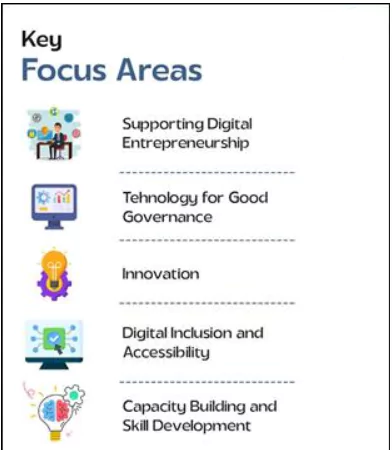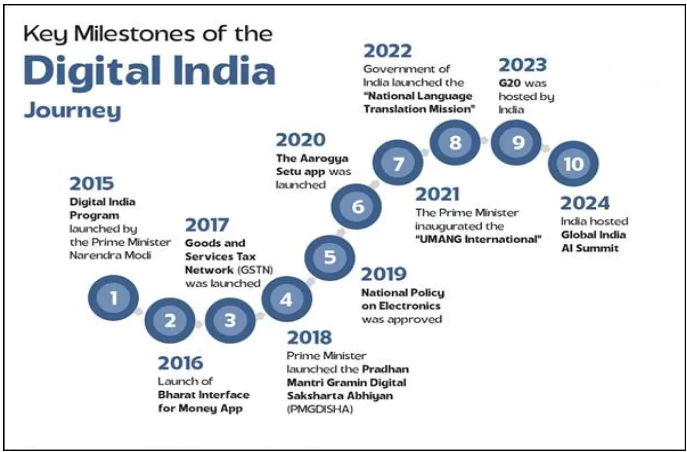On 1st July 2025, India celebrated ten years of the Digital India initiative, which has significantly transformed the nation’s digital, financial, and governance landscape driving India towards achieving Vision @ 2047.
About Digital India Mission

- Launched on 1st July 2015 by Prime Minister Narendra Modi, the Digital India Mission aimed to transform India into a digitally empowered society and knowledge economy by enhancing internet access, improving digital infrastructure, and promoting digital services for all citizens.
- Nodal Ministry: Ministry of Electronics and Information Technology (MeitY)
- Key Components
- Digital Infrastructure as a Core Utility
- Governance and Services on Demand
- Digital Empowerment of Citizens
- The mission focuses on inclusion, affordability, accessibility, and innovation to bridge the digital divide and empower all sections of society.

Key Areas of Impact in Ten Years of Digital India
- Connectivity and Infrastructure: Digital India has dramatically expanded India’s digital backbone, connecting remote regions and villages.
- Over 4.74 lakh 5G towers have been installed, covering 99.6% of districts as of 2025, while BharatNet connected 2.18 lakh Gram Panchayats with high-speed internet.
- Internet and Telecom Expansion: The initiative has made internet access affordable and widespread across urban and rural areas.
- Internet connections surged from 25.15 crore in 2014 to 96.96 crore in 2024, while data costs fell from ₹308 per GB in 2014 to just ₹9.34 in 2022.
- Digital Financial Inclusion: Digital platforms have driven financial inclusion and global leadership in digital payments.
- In April 2025, UPI recorded 1,867.7 crore transactions worth ₹24.77 lakh crore in a single month. India now handles 49% of global real-time transactions.
- E-Governance and Public Service Delivery: E-governance initiatives have made services more accessible, transparent, and efficient for citizens.
- DigiLocker reached 53.92 crore users by June 2025.
- UMANG offers 2,300 services in 23 languages with 8.34 crore users and 597 crore transactions by mid-2025.
- Direct Benefit Transfer (DBT) saved over ₹3.48 lakh crore by eliminating fake beneficiaries.
- Boost to Digital Commerce: The mission has empowered small businesses to access digital marketplaces.
- ONDC, launched in 2022, now covers 616+ cities and supports 7.64 lakh sellers.
- Government e-Marketplace (GeM) recorded ₹4.09 lakh crore GMV in just ten months of FY 2024–25.
- Advancing AI and Semiconductor Capabilities: Digital India has strengthened India’s position in emerging technologies.
- IndiaAI Mission, launched in 2024, achieved 34,000 GPUs of national compute capacity by May 2025.
- India Semiconductor Mission (ISM) approved six semiconductor projects worth ₹1.55 lakh crore, with five units under construction.
- Language Accessibility through BHASHINI: The mission ensures digital inclusivity across languages, making essential services accessible to all.
- BHASHINI supports 35+ languages with 1,600 AI models, breaking language barriers across platforms like IRCTC and NPCI.
- Capacity Building and Civil Services Training: Digital India has strengthened governance through capacity building and digital skills development.
- Mission Karmayogi’s iGOT platform has onboarded over 1.21 crore officials with 3.24 crore learning certificates issued by May 2025.
Persisting Challenges in Digital India Mission
- Inadequate Digital Infrastructure: Many remote and rural areas still face poor internet connectivity and low-speed networks, limiting the reach of digital services.
- Implementation Delay: Under BharatNet Phase-II, about 65,000 GPs in 8 States are being implemented by the State Government under the State-led model.
- The implementation of the same is not meeting the targeted time-lines as State Governments are responsible for implementation.
- Low Digital Literacy: A large section of the population, especially in rural India, lacks basic digital skills, reducing their ability to effectively use digital platforms and services despite their availability.
- Only 38% of households of India are considered digitally literate with Urban areas showing a higher rate of digital literacy (61%) compared to rural areas (25%).
- Rise in Digital Crimes: The increasing cases of cyber fraud, data breaches, and online financial scams, as reported by PIB’s cyber safety updates, pose significant threats to user trust and digital security.
- In 2025, India is projected to experience a significant rise in digital crimes, with estimated losses reaching ₹20,000 crore.
- Regional and Gender Disparities: There is a wide regional gap in digital adoption, with states like Kerala leading while several northeastern states lag behind. Additionally, women’s digital access remains significantly lower, reflecting a persistent gender divide.
- As per NSO data over half (51.6%) of women in rural areas do not own a mobile phone
Vision @ 2047 and Digital India
Digital India is a key catalyst in achieving the Vision @ 2047 by strengthening the four pillars of Viksit Bharat i.e. Yuva (Youth), Garib (Poor), Mahila (Women) and Kisan (Framers) through digital empowerment, innovation, and equitable access to opportunities.
- Digital Inclusion: Digital India has successfully expanded internet access to remote areas, making essential services like healthcare, education, and banking easily accessible online.
- For example, farmers are benefiting through access to digital platforms like e-NAM for transparent agricultural marketing, Kisan Suvidha App for real-time weather and market updates, and Direct Benefit Transfer (DBT) for timely subsidy payments.
- Growing Digital Economy: India’s digital economy contributed 11.74% to the national income in 2022–23 and is expected to reach 13.42% by 2024–25, with a vision to contribute nearly 20% by 2030.
- Technological Empowerment: Driven by artificial intelligence, cloud computing, and robust digital infrastructure, Digital India is creating new jobs, fostering entrepreneurship, and powering the Viksit Bharat vision.
- Digital modes of enhancing financial inclusion for women by targeting self-help groups (SHGs) is accelerating and promoting digital financial inclusion in India.
- Bridging Opportunity Gaps: Digital India has not only connected people to technology but has also brought them closer to growth opportunities, enabling inclusive development in line with the Viksit Bharat mission.
- For example, youth are benefiting through digital platforms like Skill India, DigiLocker, and online entrepreneurship opportunities, enhancing employment prospects.
|
Conclusion
To fully realise the Vision @ 2047, India must address persisting challenges like digital infrastructure gaps, low digital literacy, rising cybercrime, and regional and gender disparities. Strengthening implementation, enhancing cybersecurity, promoting digital skilling, and ensuring equitable access will be essential to make Digital India a truly inclusive, resilient, and transformative driver of national progress.
![]() 2 Jul 2025
2 Jul 2025



